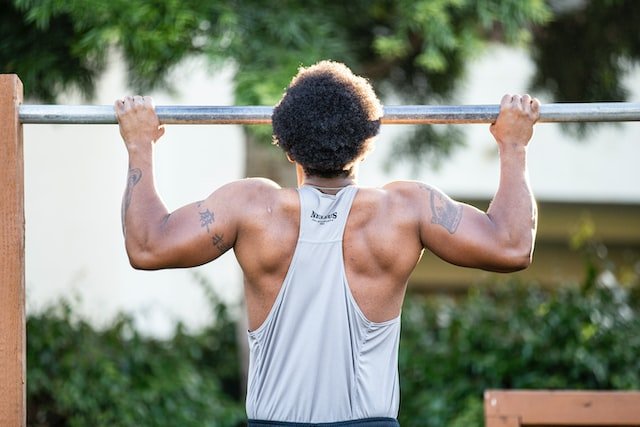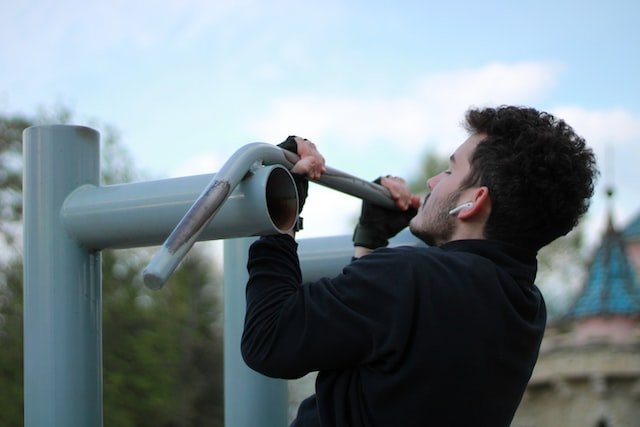
Why Do I Feel My Biceps When Doing Pull Ups? Answers Here
Have you ever felt like your biceps are working more than your back muscles when doing pull ups? Many of us have experienced this, leaving us wondering why it happens and if there’s something we should do about it.
It can be frustrating at times, as you don’t feel like you are making any progress with this exercise but can’t figure out why?
If you are a fitness enthusiast looking for answers to these questions then this article is for you!
We will dive into why you might feel your biceps more when doing pull ups and discuss what you can do to maximize the potential benefit of this exercise in targeting those lat muscles!
Why do I feel my biceps when doing pull ups?
The main reason for feeling your biceps when doing pull ups is that you are pulling with your arms and aren’t engaging your lats properly. When you pull yourself up, your biceps will be doing most of the work and your lats won’t be used as much as they should be. To engage your lats more when doing pull ups, make sure to retract your scapula (shoulder blades). This will help activate those muscles more and give you a better form. Another factor to consider is that the range of motion might be too limited. Make sure to practice doing pull ups with full range of motion, as this will ensure that both your biceps and lats are worked thoroughly during each repetition. This will also help prevent injuries due to improper form. Lastly, it’s important to remember that biceps are a much smaller muscle group than the lats, so they can fatigue relatively quickly. This means that when you do multiple repetitions of pull ups, your biceps will be working more than your lats and thus feel more tired. To prevent this from happening, practice mind-muscle connection during each repetition to ensure that your lats are engaged properly. In addition to the above tips, you may also benefit from trying different grip positions like neutral and thumbless during pull ups. This will help challenge your muscles in new ways and prevent imbalances due to overworking certain muscle groups and help you to engage your lats more. Finally, practice negatives (lowering yourself slowly) as this will help fatigue your biceps less and also allow you to better focus on engaging your lats.
Let’s now look more in-depth at the reasons why you are feeling pull ups more in your biceps, rather than your lats…
Pulling with biceps
The main reason why you feel your biceps when doing pull ups is that you are pulling with your arms and not engaging your lats. When you pull yourself up, your biceps will be doing most of the work and your lats won’t be used as much as they should be.
Engaging the lats is crucial when doing any kind of back exercise because it helps to target the correct muscle group more effectively.
If you are new to exercise and lifting, you may naturally pull with your biceps, as your form isn’t quite there yet, but don’t worry – with time and practice, you’ll be able to get the hang of it.
Increase the quality of your pull-ups by engaging the lats and bringing into play scapular retraction. This will ensure that you’ve activated the correct set of muscles and you’ll be able to rely less on your biceps. With some practice and perseverance, soon enough it’ll become second nature!
Although you may feel a bit uneasy at first, once you get the hang of it, this exercise will be transformed into something entirely new and hopefully exciting.
Tight grip
In addition to engaging your lats properly, you may also suffer from a lack of lat engagement due to using too much grip during pull-ups.
This can be a hindrance when trying to engage the correct set of muscles because your grip is simply too strong. If this is happening to you, then it’s a good idea to loosen your grip slightly when doing pull-ups.
The reason for this is that if your grip is too strong, it will limit the range of motion that you’re able to achieve and this can restrict your ability to engage the lat muscles. Loosening your grip slightly should help to increase the range of motion and thus allow for more muscle engagement.
Having a tight grip will also encourage your biceps to take over the majority of the work as you will in effect be “flexing” them, thus making it harder to feel your lats working.
One other thing that could help you to engage the lats more and biceps less would be to try out different types of grip…
Try different grip positions
Trying various types of grips can make a massive difference when it comes to feeling this exercise more in your biceps because it changes the emphasis of the exercise from pull to lift. This can help you to engage your lats more, as well as other muscles in your back and shoulders.
- A neutral grip – your palms will be facing each other which is great for engaging your lats and also helps to encourage proper straight-arm form.
- A thumbless grip – this is when you keep your thumbs off the bar during pull ups and this can help you to engage more of your back muscles than with a regular grip.
- A wide supinated grip – this is when the palms face towards you, although this is a more advanced level grip and can put more strain on your wrists and elbows.
- A narrower pronated grip – is when the palms face away from you, and this can help to increase the amount of lat engagement you feel.
You can maximize your workout intensity by switching up the grip on your exercises. For example, a wide or narrow grip will target different muscle groups and increase the range of motion. Keep in mind that when you opt for a more narrow grip, you’ll receive greater bicep engagement!

Retract Scapula
When doing pull ups, it is important to retract your scapula (shoulder blades). This will help activate those all-important lat muscles and give you better form when doing the exercise. It also ensures that your lats get the maximum benefit from this exercise.
To achieve proper scapular retraction, start by taking a big breath in and then tucking your shoulders back as you exhale. This will provide the necessary stability for you to pull and also reduce any strain on your shoulders.
Make sure to keep your chest up and keep a slight arch in your back throughout the entire exercise. This will ensure that you are engaging the right muscles and not just relying on your biceps to do all of the work.
Even with the slightest of pulling motions, it’s impossible NOT to engage your biceps, as they naturally provide you with stability and balance. However, with proper form and focus on engaging the lats you can minimize the bicep involvement and get a great workout for your back muscles.
Form is crucial
Your form during pull ups also plays an important role in targeting the correct muscle group and should be taken into consideration. Your body should be perfectly aligned with your shoulders back and a slight arch in your back.
Keep your lower body still and focus on pulling your elbows back towards your sides as you move up and down. This will help you to engage the correct muscles and ensure that your biceps are not doing all of the work.
This will ensure that you are engaging the lats effectively and also provide you with better balance and control during the exercise. It also helps to distribute the load more evenly across the body, which can help prevent injuries from occurring.
You want to change the way you think about the exercise too. Don’t think about pulling yourself up towards the bar instead think about pulling the bar to YOU.
Sounds a little crazy, but when doing this I find it helps my form and reduces the amount of bicep engagement. I do a pull up the same way I do lat pulldowns, by engaging my scapula and pulling down from my elbows. Give it a try and see how you get on with it.
Related: Why am I not feeling lats on back exercises?
Full range of motion
Another factor to consider is that the range of motion might be too limited. When done properly, full range of motion should be used for every repetition, as this will ensure that both your biceps and lats are getting the full benefit from the exercise.
This means that you should pull until your chin is above the bar and then lower all the way down so that your arms are extended. This will help to increase the intensity of your workout and also ensure that you are engaging both lats and biceps, rather than relying on just one muscle group.
Lots of people do not lower themselves back down, which means their biceps are always engaged, as the time under tension is increased. This can lead to overdevelopment of the biceps and can also cause injury, as the biceps are not designed to handle this type of load.
The key is to focus on controlled movements and ensure that you are using a full range of motion. By doing this, you will be able to target both muscle groups effectively and get the best results from your workout.
Are you doing chin ups?
This might sound obvious but I have to mention it…you may be feeling your biceps when doing pull ups because you are actually doing chin ups!
Chin ups involve a narrower grip and your palms facing you, whereas pull ups are done with a wider grip (shoulder width or wider) and your palms facing away from you.
The difference in the way that you hold the bar can make all the difference when it comes to targeting different muscles. So if you think that you are doing pull ups, but you’re actually doing chin ups, then this could be the reason why your biceps are feeling so engaged when you perform the exercise.
Although chin ups are comparable to pull ups, the bicep engagement is significantly higher. That’s why if you opt for chin ups instead of pull ups, your biceps will be feeling extra engaged!

Size of muscle groups
The biceps are a smaller muscle group, compared to the lats, and so are naturally going to fatigue quicker during pull ups.
The biceps are made up of two different heads, the long head and the short head, their correct names being the biceps brachii and the brachialis.
The lats, on the other hand, are a much larger muscle group that extends from your lower back all the way up to your shoulders. They are made up of three different heads – the long head, the middle head and the short head, so they are naturally going to be stronger and more capable of handling the load during pull ups.
Even though the biceps are a smaller muscle group, they can still become overdeveloped if you focus too much on them when doing pull ups. To prevent this from happening, make sure that you engage your lats and use proper form throughout the entire range of motion.
Weaker biceps and fatigue
Another reason why you could be feeling pull ups in your biceps is because they are simply weaker than your lats. If this is the case, then it might be wise to focus on strengthening your biceps before attempting pull ups again.
You can do this by starting with assisted pull ups and gradually decreasing the amount of assistance, as your biceps begin to get stronger. You could also incorporate some isolation exercises into your routine, such as barbell curls or hammer curls, which will help to strengthen your biceps and prepare them for pull ups.
Fatigue also plays a big role in bicep engagement during pull ups. If you’ve been pushing yourself to the limit during your workout, then it could be that your biceps are simply too tired and fatigued to lift the weight properly.
In this case, it’s important to take regular breaks throughout your workout and remember not to overdo it. You should also focus on form and technique, rather than trying to lift as much weight as possible.
Related: Why do I feel lat pulldowns in my core?
Mind muscle connection
When it comes to improving your pull-up form, developing a good mind-muscle connection is key. A strong mind-muscle connection will help you to visualize which muscles you are targeting and ensure that you are engaging them properly throughout each rep.
To develop this connection, focus on contracting the muscles in your back as you begin to pull up, before slowly releasing them as you lower yourself down. Make sure to keep your shoulders back and slightly arched throughout the movement, and try to be aware of the tension in your back muscles as you pull up and down.
By developing a strong mind-muscle connection, you will be able to consciously engage your lats during pull ups, while still maintaining proper form. This will help to minimize bicep engagement and ensure that you are targeting the right muscle group.
Get a gym buddy to give your lats a poke just before you start the exercise, as this can help you to feel the correct muscles and to engage them, while also ensuring that your body is in the correct position.
Practice
When it comes to mastering pull ups, practice is key. The more you do them, the stronger and more confident you become in executing perfect form and technique.
It can be beneficial to try different hand positions when doing pull ups, as this helps to target different areas of the back and can also work other muscles such as the grip and forearms.
For example, you could try using a neutral grip (palms facing each other) or even a thumbless grip (pinkies together) to help keep your shoulders in a neutral position during the exercise.
It is also important to practice negatives, use a spotter for assistance when needed or use resistance bands to reduce the load.
Negatives are where you lower yourself back down from the bar as slowly as possible, instead of jumping or letting go immediately. This helps to build strength in the biceps and lats, but should be done with caution so as not to cause injury.
Final thoughts…
Pull ups can be a great way to strengthen your back, but it is important to keep in mind why you are feeling the exercise in your biceps and make sure that your form and technique are correct.
Focus on engaging the lats and maintaining proper form throughout the exercise. Also, try different hand positions and practice negatives to help target the lats and build strength in the biceps.
Finally, remember to take regular breaks throughout your workout and practice regularly to ensure that you are able to master the pull up correctly for maximum benefit. Good luck!
Do you feel your biceps when doing pull ups and have these tips helped? Let me know in the comments below.


